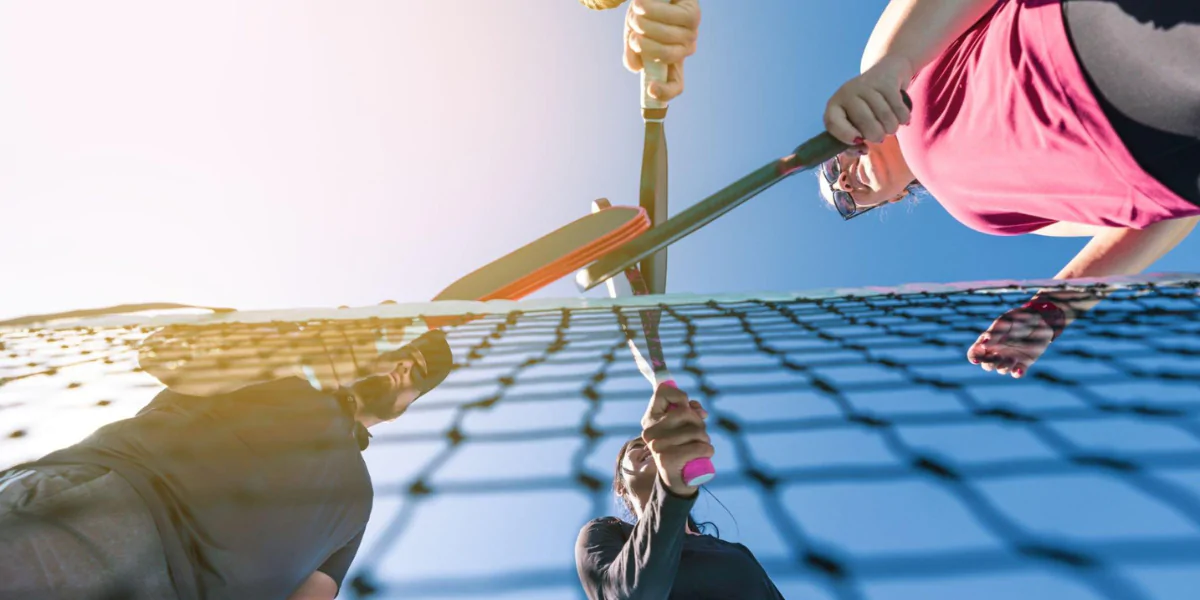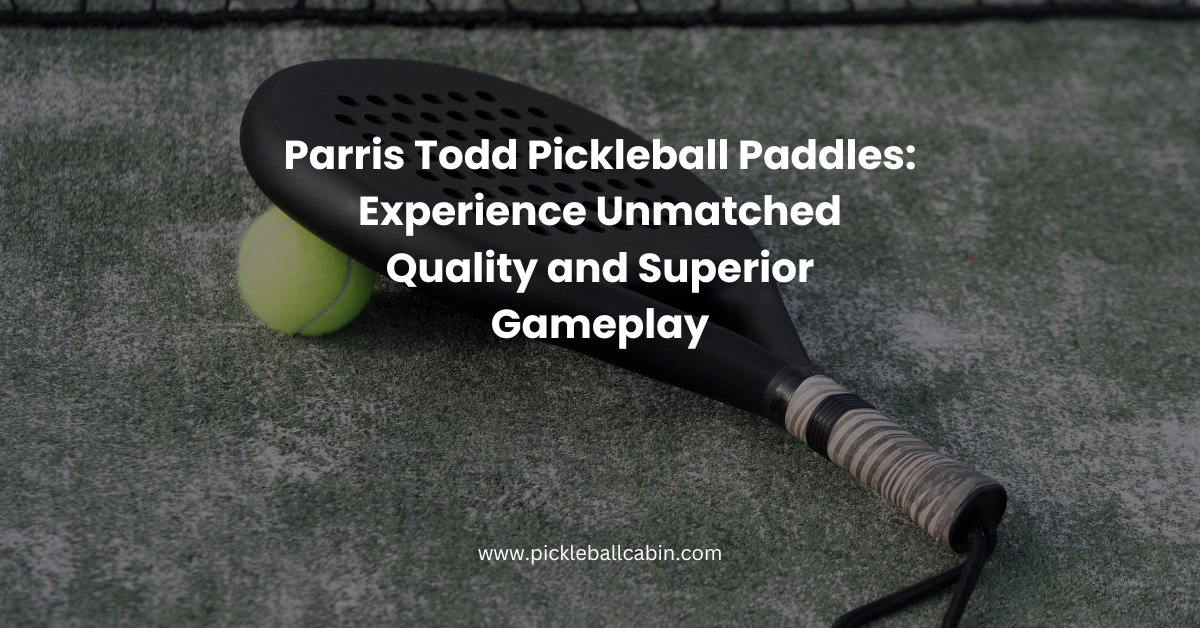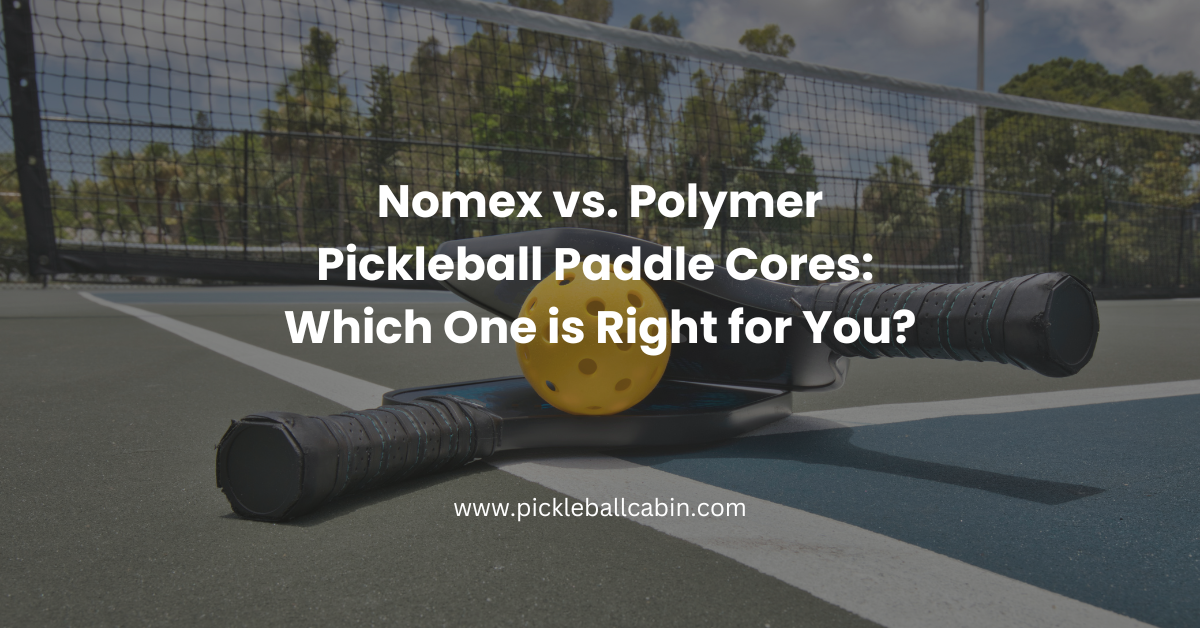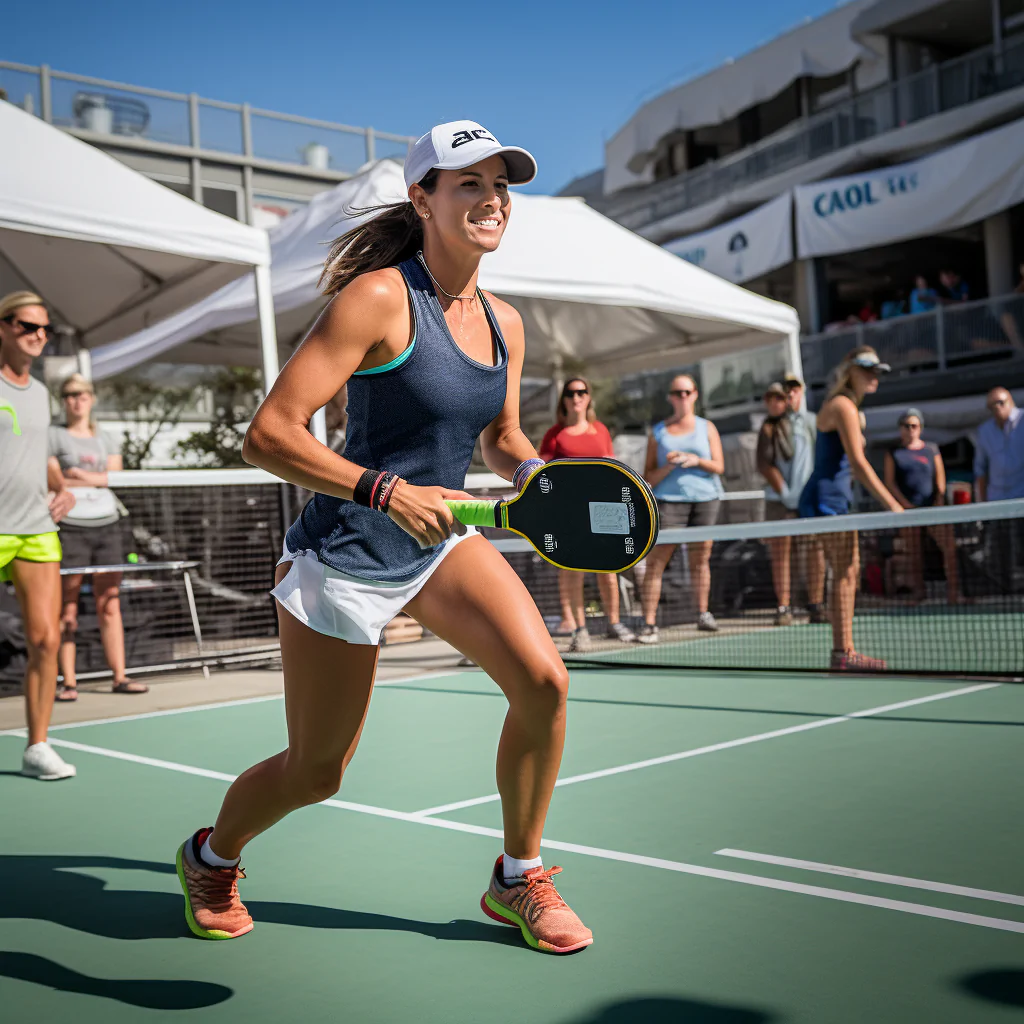Kind of Balls In Pickleball?
Pickleball is played with a paddle and a plastic ball with holes, similar to a wiffle ball. But what kind of ball is used in pickleball? How is it different from other balls used in racquet sports? And where can you buy pickleballs? In this article, we will answer these questions and more.
The Original Pickleball Was Actually A Wiffle Ball
Pickleball was invented in 1965 by three friends, Joel Pritchard, Bill Bell and Barney McCallum, who wanted to play badminton but could not find a shuttlecock. They improvised with a wiffle ball, some plywood paddles and a lowered badminton net. They named the game after Pritchard’s dog, Pickles, who loved to chase the ball.
You may also Like to Read in Details on who invented pickleball
The original pickleball was actually a wiffle ball, which is a plastic ball with holes that is used for playing baseball or softball. However, as the game evolved, the players realized that they needed a different kind of ball that would suit the unique characteristics of pickleball.
Characteristics Of A Pickleball
A pickleball is a plastic ball with holes that is designed specifically for playing pickleball. A pickleball has the following characteristics:
- It has 74 mm (2.9 inches) in diameter and weighs about 25 grams (0.88 ounces).
- It has 26 to 40 holes of varying sizes and shapes that affect the flight and bounce of the ball.
- It has a smooth or textured surface that influences the spin and speed of the ball.
- It has different colors for easy visibility, such as yellow, orange, or neon green.
- It has different hardness and durability depending on whether it is used indoors or outdoors.
How Is A Pickleball Different From A Wiffle Ball?
A pickleball is different from a wiffle ball in several ways:
- A pickleball is larger, heavier, harder and faster than a wiffle ball.
- A pickleball has fewer holes than a wiffle ball, which reduces drag and wind resistance.
- A pickleball has smaller holes than a wiffle ball, which increases bounce and power.
- A pickleball has a textured surface that allows more spin than a wiffle ball.
Pickleballs Vs Balls Used In Other Racquet Sports
Pickleballs are different from balls used in other racquet sports, such as tennis, racquetball and squash. Here are some comparisons between pickleballs and these balls:
Pickleballs Vs Tennis Balls
Tennis balls are much larger, heavier and softer than pickleballs. Tennis balls have 66 mm (2.6 inches) in diameter and weigh about 58 grams (2 ounces). Tennis balls have felt covering that makes them fuzzy and bouncy. Tennis balls are pressurized to maintain their bounce and performance.
Pickleballs are smaller, lighter and harder than tennis balls. Pickleballs have 74 mm (2.9 inches) in diameter and weigh about 25 grams (0.88 ounces). Pickleballs have plastic covering that makes them smooth and fast. Pickleballs are not pressurized and rely on the holes for their bounce and performance.
Pickleballs Vs Racquetballs
Racquetballs are slightly smaller, lighter and softer than pickleballs. Racquetballs have 57 mm (2.25 inches) in diameter and weigh about 40 grams (1.4 ounces). Racquetballs have rubber covering that makes them elastic and lively. Racquetballs are pressurized to maintain their bounce and performance.
Pickleballs are slightly larger, heavier and harder than racquetballs. Pickleballs have 74 mm (2.9 inches) in diameter and weigh about 25 grams (0.88 ounces). Pickleballs have plastic covering that makes them smooth and fast. Pickleballs are not pressurized and rely on the holes for their bounce and performance.
Pickleballs Vs Squash Balls
Squash balls are much smaller, lighter and softer than pickleballs. Squash balls have 40 mm (1.6 inches) in diameter and weigh about 24 grams (0.85 ounces). Squash balls have rubber covering that makes them squashy and slow. Squash balls are not pressurized and have different colors to indicate their speed and bounce.
Pickleballs are much larger, heavier and harder than squash balls. Pickleballs have 74 mm (2.9 inches) in diameter and weigh about 25 grams (0.88 ounces). Pickleballs have plastic covering that makes them smooth and fast. Pickleballs are not pressurized and rely on the holes for their bounce and performance.
Also Read; pickleball balls
Types of Pickleball Balls
There are two types of pickleball balls: indoor and outdoor. The type of ball you use depends on where you play pickleball: indoors or outdoors.
Outdoor Pickleball Balls
Outdoor pickleball balls are heavier and harder than indoor balls. They have smaller holes and a smooth surface that reduces drag and wind resistance. Outdoor balls are faster and more powerful than indoor balls, but they also require more finesse and accuracy. They are also louder and more likely to cause bruises when they hit the body. Outdoor balls are suitable for playing on rough surfaces like concrete or asphalt.
Some examples of outdoor pickleball balls are:
- Onix Pure 2: This is one of the most popular outdoor pickleball balls in the market. It has 40 small holes that create a balanced flight pattern and a consistent bounce. It has a two-piece construction that makes it durable and resistant to cracking or splitting. It has a bright yellow color for easy visibility.
- Dura Fast 40: This is another popular outdoor pickleball ball in the market. It has 40 small holes that create a stable flight pattern and a consistent bounce. It has a one-piece construction that makes it strong and resilient to cracking or splitting. It has various colors for easy visibility.
- Franklin X-40: This is a newer outdoor pickleball ball in the market. It has 40 small holes that create a smooth flight pattern and a consistent bounce. It has a seamless construction that makes it durable and resistant to cracking or splitting. It has a neon green color for easy visibility.
Indoor Pickleball Balls
Indoor pickleball balls are softer and lighter than outdoor balls. They have larger holes and a textured surface that allows them to spin more easily. Indoor balls are easier to control but harder to hit with power. They are also quieter and less painful when they hit the body. Indoor balls are suitable for playing on smooth surfaces like gym floors.
Some examples of indoor pickleball balls are:
- Onix Fuse: This is one of the most popular indoor pickleball balls in the market. It has 26 large holes that create a balanced flight pattern and a consistent bounce. It has a two-piece construction that makes it durable and resistant to cracking or splitting. It has a bright orange color for easy visibility.
- Jugs Bulldog: This is another popular indoor pickleball ball in the market. It has 26 large holes that create a stable flight pattern and a consistent bounce. It has a one-piece construction that makes it strong and resilient to cracking or splitting. It has various colors for easy visibility.
- Gamma Photon: This is a newer indoor pickleball ball in the market. It has 26 large holes that create a smooth flight pattern and a consistent bounce. It has a seamless construction that makes it durable and resistant to cracking or splitting. It has a neon green color for easy visibility.
Indoor vs Outdoor: How to choose?
The type of ball you choose depends on where you play pickleball: indoors or outdoors. Here are some tips to help you choose:
- If you play indoors, choose an indoor ball that is softer, lighter, larger-holed, textured and easier to control. Some examples are Onix Fuse, Jugs Bulldog and Gamma Photon.
- If you play outdoors, choose an outdoor ball that is heavier, harder, smaller-holed, smooth and faster. Some examples are Onix Pure 2, Dura Fast 40 and Franklin X-40.
- If you play both indoors and outdoors, you can either buy both types of balls or choose a hybrid ball that can work well in both environments. Some examples are Onix Fuse G2, Dura Big Hole and Franklin X-26.
- If you are a beginner, choose a ball that is softer, lighter and easier to control. You can also choose a brighter color for better visibility. Some examples are Onix Fuse, Jugs Bulldog and Franklin X-40.
- If you are an advanced player, choose a ball that is harder, heavier and faster. You can also choose a darker color for more challenge. Some examples are Onix Pure 2, Dura Fast 40 and Gamma Photon.
Read More here at; what is the difference between indoor and outdoor pickleball balls
Official Pickleball Ball Rules
The official rules of pickleball specify that the ball must meet the following criteria:
- The ball must be made of durable plastic material with a smooth or textured surface.
- The ball must have a diameter of 2.874 inches (73 mm) to 2.972 inches (75.5 mm).
- The ball must weigh between 0.78 ounces (22 grams) to 0.935 ounces (26.5 grams).
- The ball must have 26 to 40 circular holes with spacing as even as possible.
- The ball must have a bounce of 30 inches (76.2 cm) to 34 inches (86.4 cm) when dropped from a height of 78 inches (198.1 cm) on a hard surface at room temperature.
- The ball must have a hardness of 40 to 50 on the Durometer D scale or 65 to 75 on the Rockwell R scale.
- The ball must be approved by the USA Pickleball Association (USAPA) or the International Federation of Pickleball (IFP).
You can find the list of approved pickleball balls on the USAPA website or the IFP website.
Pickleball Ball Colors
Pickleball balls come in various colors for different purposes and preferences. Here are some common colors and their meanings:
- Yellow: This is the most popular color for pickleball balls because it is easy to see in most lighting conditions and backgrounds. Yellow balls are also used in most tournaments and official events.
- Orange: This is another popular color for pickleball balls because it is also easy to see in most lighting conditions and backgrounds. Orange balls are also used in some tournaments and official events.
- Neon Green: This is a newer color for pickleball balls that is becoming more popular because it is very bright and visible in most lighting conditions and backgrounds. Neon green balls are also used in some tournaments and official events.
- White: This is the original color for pickleball balls because it was the same as wiffle balls. White balls are still used by some players who prefer a classic look or a more challenging game. White balls are harder to see in some lighting conditions and backgrounds.
- Other Colors: There are also other colors for pickleball balls, such as pink, blue, purple, red, black and more. These colors are usually used for personal preference or fun. They are not commonly used in tournaments or official events.
How long do pickleballs last?
Pickleballs are not very durable and tend to wear out or break after repeated use. The lifespan of a pickleball depends on several factors, such as:
- The playing style: If you play aggressively or hit the ball hard, you will wear out or break the ball faster than if you play gently or softly.
- The playing surface: If you play on rough surfaces like concrete or asphalt, you will wear out or break the ball faster than if you play on smooth surfaces like gym floors or wood courts.
- The temperature: If you play in hot or cold temperatures, you will wear out or break the ball faster than if you play in moderate temperatures.
- The quality of the ball: If you buy cheap or low-quality balls, you will wear out or break them faster than if you buy expensive or high-quality balls.
Some signs that a pickleball needs to be replaced are:
- Soft spots: If the ball feels soft or squishy when you squeeze it, it means that it has lost its air pressure or integrity and needs to be replaced.
- Cracks: If the ball has visible cracks or splits on its surface, it means that it has been damaged by impact or stress and needs to be replaced.
- Out-of-roundness: If the ball does not roll smoothly or evenly on a flat surface, it means that it has lost its shape or balance and needs to be replaced.
- Loss of bounce: If the ball does not bounce as high or as consistently as it used to, it means that it has lost its elasticity or resilience and needs to be replaced.
Are all pickleballs the same?
No, not all pickleballs are the same. There are different types, brands, models and qualities of pickleballs that have different characteristics and performance. Some of the factors that differentiate pickleballs are:
- The type: There are indoor and outdoor pickleballs that have different weight, hardness, size, hole pattern and surface texture.
- The brand: There are various brands of pickleballs that have different reputation, quality, price and availability.
- The model: There are various models of pickleballs within each brand that have different features, design and performance.
- The quality: There are various qualities of pickleballs within each model that have different durability, consistency and reliability.
Some of the most popular and reputable brands of pickleballs are:
- Onix: Onix is one of the leading brands of pickleballs that offers high-quality balls for both indoor and outdoor play. Some of their best-selling models are Onix Pure 2, Onix Fuse and Onix Fuse G2.
- Dura: Dura is another leading brand of pickleballs that offers high-quality balls for outdoor play. Some of their best-selling models are Dura Fast 40, Dura Big Hole and Dura Ace.
- Franklin: Franklin is a newer brand of pickleballs that offers high-quality balls for both indoor and outdoor play. Some of their best-selling models are Franklin X-40, Franklin X-26 and Franklin Optic.
- Gamma: Gamma is a well-known brand of racquet sports equipment that also offers high-quality balls for indoor play. Some of their best-selling models are Gamma Photon, Gamma Fusion and Gamma Atomic.
You Also Like; best pickleball balls
Pickleball Balls vs Wiffleball Balls
Pickleball balls are not the same as wiffle balls, although they look similar. Wiffle balls are smaller, lighter, softer and have fewer holes than pickleball balls. Wiffle balls are designed for playing baseball or softball, not pickleball. Wiffle balls do not meet the official standards of pickleball and may not perform well on the court.
Some of the differences between pickleball balls and wiffle balls are:
- Size: Wiffle balls have 70 mm (2.75 inches) in diameter, while pickleball balls have 74 mm (2.9 inches) in diameter.
- Weight: Wiffle balls weigh about 20 grams (0.7 ounces), while pickleball balls weigh about 25 grams (0.88 ounces).
- Hardness: Wiffle balls have a hardness of 30 to 40 on the Durometer D scale or 55 to 65 on the Rockwell R scale, while pickleball balls have a hardness of 40 to 50 on the Durometer D scale or 65 to 75 on the Rockwell R scale.
- Holes: Wiffle balls have eight oblong holes on one hemisphere, while pickleball balls have 26 to 40 circular holes evenly distributed on both hemispheres.
Quiet Pickleball Balls
Some pickleball players may prefer quieter balls to reduce noise complaints from neighbors or other players. There are some brands that offer quiet pickleball balls, such as:
- Gamma: Gamma offers quiet pickleball balls for indoor play, such as Gamma Photon, Gamma Fusion and Gamma Atomic. These balls have softer materials and smaller holes that reduce the sound when they hit the paddle or the net.
- Onix: Onix offers quiet pickleball balls for both indoor and outdoor play, such as Onix Fuse G2 and Onix Fuse. These balls have softer materials and larger holes that reduce the sound when they hit the paddle or the net.




